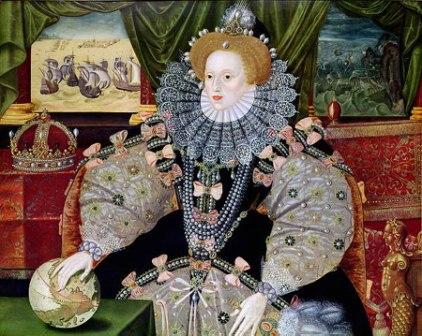 |
| Advertisement for the Gamm Theatre's production of 'King Elizabeth'. © Gamm Theatre |
Many of the most familiar faces of the Elizabethan court were present in the cast of characters, and each character was brought to life by a gifted actor or actress. The show did make some interesting choices when casting their roles, like having Master Davison, the man Elizabeth entrusted with the signed death warrant of Mary, Queen of Scots, portrayed by a woman. As the characters in King Elizabeth all wore modern clothes, this gender reversal did not seem inappropriate, although it would have been inaccurate to have a woman serve as a personal secretary in the sixteenth century.
As a historian, I relished all of the historical details included in the script, and was delighted to find that real quotes said by Queen Elizabeth I were included in the dialogue, as were the contents of real letters written by Mary, Queen of Scots. These details gave the show credibility, and added to the emotionally compelling scenes.
History tells us that Queen Elizabeth I never met her cousin, Mary Stuart, face-to-face, although they did write many letters to one another throughout their lifetimes. But King Elizabeth, like so many other movies and shows examining the rivalry of these two great queens, shows us what might have passed between them, if they ever had the opportunity to meet in secret. The confrontational scene in King Elizabeth takes place when Mary, Queen of Scots is given access to the grounds outside of her jailer Amyas Paulet's home, just as Elizabeth I's hunting party is passing through. Here, the two queens face one another in the woods. Where Queen Elizabeth is level-headed and unforgiving, Mary is defiant and hysterical. Their differing personalities make for an electrifying clash on stage.
 |
| A picture of the stage. © BeingBess/A.Jensen |
Overall, I enjoyed the play. But there were some things that bothered me, because they were either inaccurate or confusing.
The modern costuming used in the play didn't add any special significance to the story adaptation. The men were dressed in either modern military wear or formal wear, while Elizabeth I wore power suits. If the ensemble was trying to send a message to the audience through their modern clothing, it was unclear to me what that message might have been. Oddly, Elizabeth finally did don a period dress when she addressed the troops at Tilbury at the end, but the play failed to explain why the Spanish Armada was invading England and who Elizabeth I was addressing in her speech. If you didn't know your Elizabethan history, you might have left the theatre feeling confused by this scene.
Although the Babington Plot is mentioned at the beginning of the play, it is never explained how Mary Stuart was involved with the conspirators, sending them damning letters snuck out of her place of imprisonment in wine barrels. Because it is not explained how complicit she was in authorizing the plans, it appears to an audience that may not know enough background, that Mary is innocent and unjustly imprisoned. Instead of having the portrayals of the two queens more balanced in this adaptation, as was apparently the goal with the re-write, Mary Stuart is portrayed once again as a tragic victim, as she was in Schiller's version of the play.
Finally, the most jarring inaccuracy that stuck out is that the theatre used a picture of Queen Mary I to represent Mary, Queen of Scots on the stage. This was the first thing I noticed when I walked into the little black-box theatre, and the last thing I saw on my way out, and it really bothered me!
If you have an opportunity to see King Elizabeth, I hope that you do. It covers a fascinating period in history, and there is nothing quite like being able to be a fly on the wall, watching the show-down between these two queenly cousins, Elizabeth Tudor and Mary Stuart.
